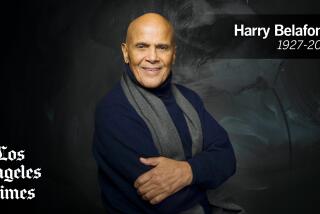In Search of the Truth About Prefontaine
EUGENE, Ore. â Steve Prefontaineâs rebirth on film comes as twins this year as he lends his name and nickname to a pair of movies. âPrefontaineâ from Disneyâs Hollywood Pictures is now playing, with âPreâ from Warner Bros. due out in the fall.
All this for an athlete from the minor sport of distance running who never won an Olympic medal, which usually is a runnerâs only ticket to recognition in this country. He set several American records on the track but wasnât even the most successful American distance runner of his time. Frank Shorter, the Munich Olympic marathon gold medalist, was.
At the time of Prefontaineâs death, in a 1975 auto accident at age 24, Shorter told of running near his Colorado home with Prefontaine. Someone shouted, âHey, isnât that Steve Prefontaine?â Shorter recognized then, âEven at home where Iâm not known, he is.â
Even then, runners admired Prefontaine because he wasnât like most runners. He wasnât as tall or as skinny, itâs true, but mostly he wasnât as diplomatic and self-effacing.
Prefontaine played to the crowds and the media, and could speak as tough as he ran. He has been called the âJames Dean of track,â but a better label might be Muhammad Ali in spikes.
Like Ali, Prefontaine made bold predictions about how well he would do battle. Like Ali, Prefontaine acted out against officials who stood for what he opposed.
Then suddenly Prefontaine died with so much left undone, both on the track and in challenging officialdom. His fans didnât want to let him go, and they havenât. But it will take more than runners with long memories and strong loyalties to turn the two movies into box-office successes.
The first film off the starting line, âPrefontaine,â does reasonably well at re-creating the look of the runner and his times. Where âPrefontaineâ stumbled was in its trifling with facts and characterizations.
Jared Leto, who plays the title character, not only looks like Prefontaine but also acts like him. His staged runs blend as well as the viewer could hope with footage of Prefontaineâs real runs from the 1970s.
But the script that Leto and his fellow actors must follow doesnât do the real Prefontaine justice. Playing fast and loose with certain facts dishonors the blunt honesty that his fans found so appealing in him.
Most of the errors only a student of running history would notice: Prefontaine leading in the last lap of the 1972 Olympic 5,000 meters when in fact he wasnât out front that late in the race, or the alleged ducking of Prefontaine by Munich gold medalist Lasse Viren when in fact they raced twice after those Games, each beating the other once.
Three more problems are more substantial:
* The film deals squeamishly with the ATU, disclaiming it as a fictional organization. This is clearly the AAU--Amateur Athletic Union--with which Prefontaine battled openly.
* Before his last race, Prefontaine rips off the âswooshâ from a new pair of shoes. He worked for Nike by then and would never have removed this already widely known logo.
* The filmmakers chose to ignore the possible role of alcohol in the fatal crash by putting a cola-looking drink in his hand at a party. (In fairness, he was twice shown intoxicated earlier in the movie.) The official police report from that night listed his blood alcohol at .16, well above the legal limit.
Beyond these factual matters, though, the main flaw in this film was the pseudo-documentary treatment of the subject. The result, perhaps inevitably, is that the characters come across as exaggerated caricatures.
Prefontaine himself wasnât entirely the angry, abrasive young man that Leto portrayed. A humorless egotist wouldnât have been so well loved.
Coach Bill Bowerman wasnât only the profane curmudgeon that R. Lee Ermey played. Bowerman was one of the few coaches (along with his assistant Bill Dellinger) wise enough to keep the driven Prefontaine from training and racing himself into the ground.
The weakness of âPrefontaine,â the movie, isnât with the performers or the script so much as the docudrama vehicle. This story has already been told, shorter and better, in the wonderfully crafted 1995 documentary âFire on the Track.â
(A chopped-up version ran on CBS-TV. See the original, available on video from Westcom Creative Group, [800] 771-2060.)
After youâve seen the real Prefontaine, Bowerman and many others, and heard the narration of novelist Ken Kesey in âFire,â the stand-ins become also-rans. Co-authoring that script was Kenny Moore, Prefontaineâs Olympic teammate as well as a writer of great skill and sensitivity. Moore also scripted âPre,â the Warner movie. One hopes heâll give deeper and truer answers to the question âWho was Steve Prefontaine?â than the film now playing.
More to Read
Only good movies
Get the Indie Focus newsletter, Mark Olsen's weekly guide to the world of cinema.
You may occasionally receive promotional content from the Los Angeles Times.










